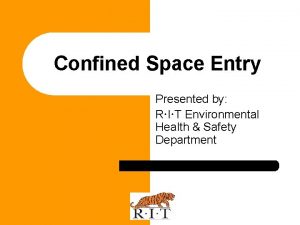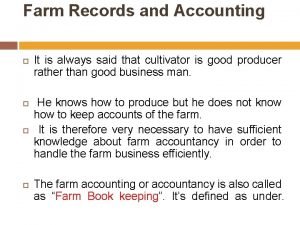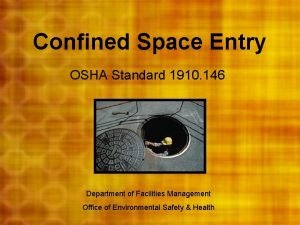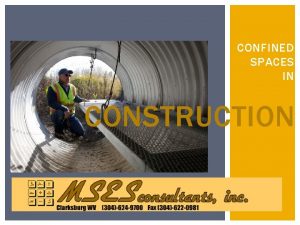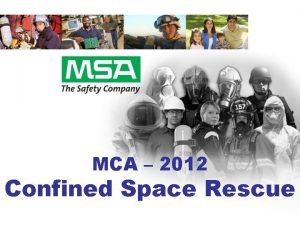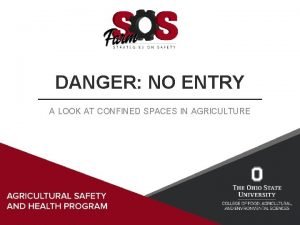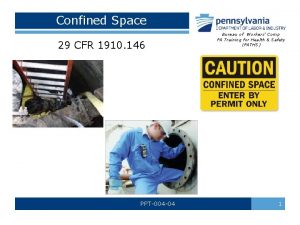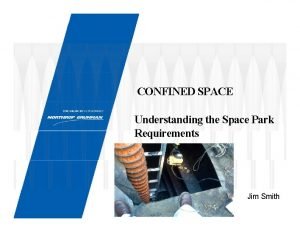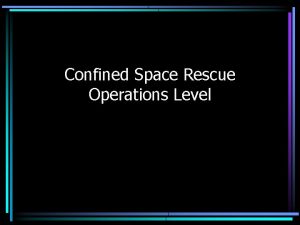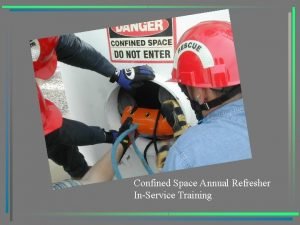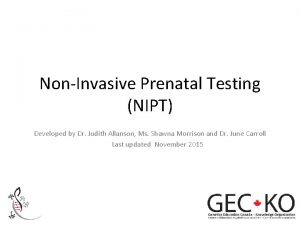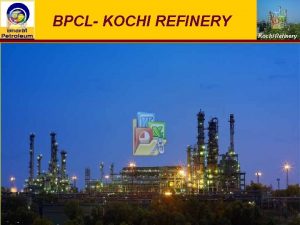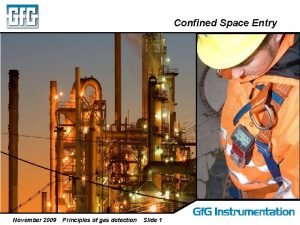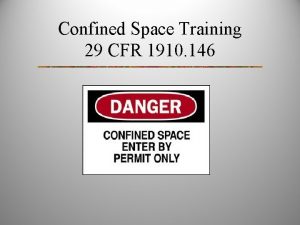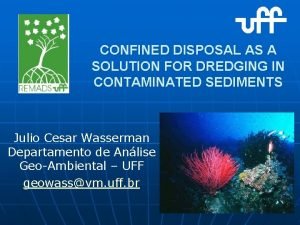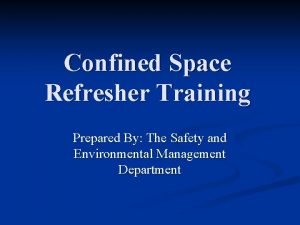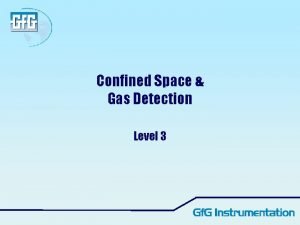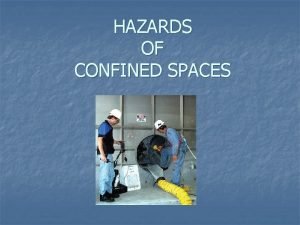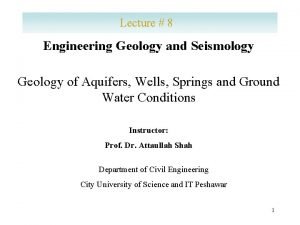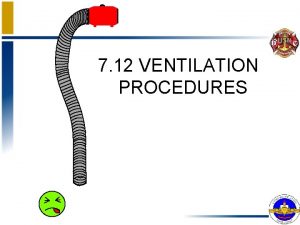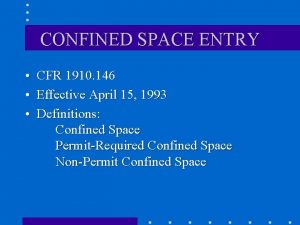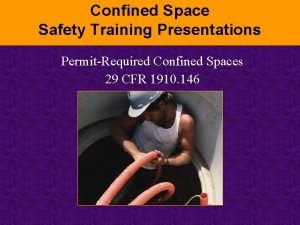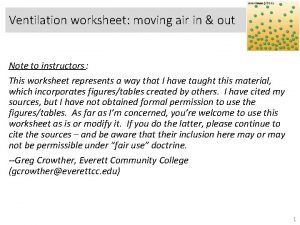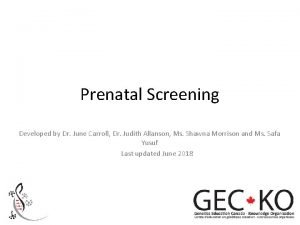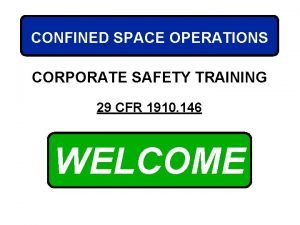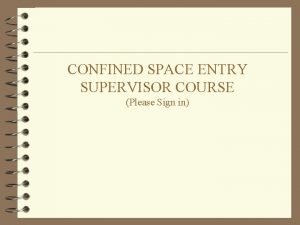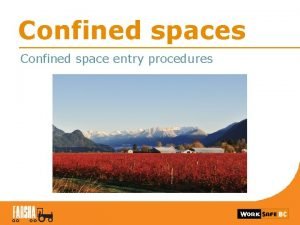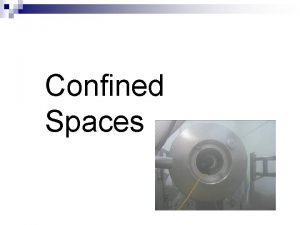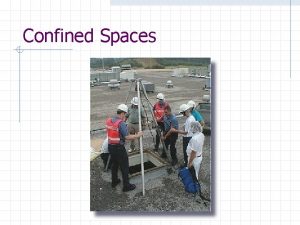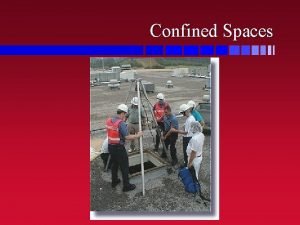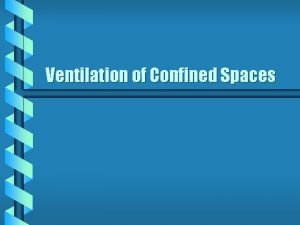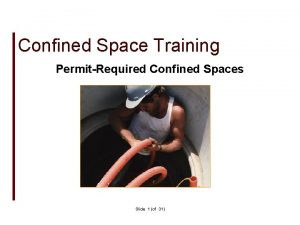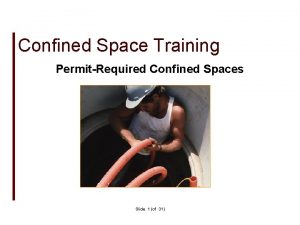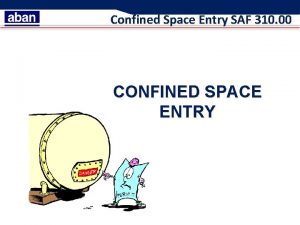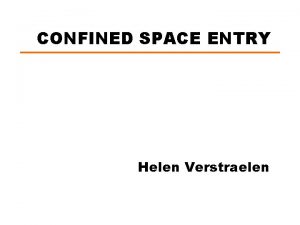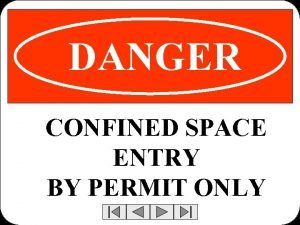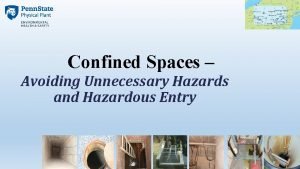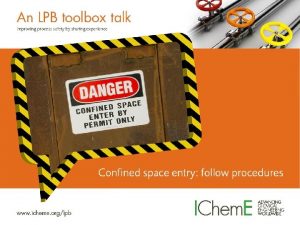DANGER NO ENTRY A LOOK AT CONFINED SPACES




































- Slides: 36

DANGER: NO ENTRY A LOOK AT CONFINED SPACES IN AGRICULTURE

Learning Objectives • Define a “confined space” • Identify confined spaces in agriculture • Recognize the hazards of agricultural confined spaces • Review management practices for confined spaces • Discuss “Permit Required” confined space practices

Definition of a Confined Space • Space large enough and so configured that a person can bodily enter and perform assigned task. • Limited or restricted means of entry and exit • Not intended for continuous human occupancy

Permit Required Confined Space • A confined space plus one or more of the following: – Contains or has potential to contain a hazardous atmosphere. – Contains a material that has the potential for engulfing or entrapment. – Has internal configuration with inwardly converging walls or floor which slopes downward to a smaller cross section. – Contains any other recognized serious safety or health hazard.

Confined Spaces in Agriculture: • Grain and Feed Storage Facilities – – – Corrugated steel bins Steel Tanks or silos Concrete silos Flat grain storage buildings Wooden feed storage structures Sumps / tunnels under storage facilities – Grain Driers Source: sxc. hu

Confined Spaces in Agriculture: • Forage Structures – Concrete stave and poured silos • (including oxygen limiting) – Wooden silos – Steel / ceramic – oxygen limiting silos (Harvestore®) – Horizontal or bulk silo Source: sxc. hu

Confined Spaces in Agriculture: • Manure Storage Structures – Below floor storage pits – Sump pits – Above ground storage tanks (Slurrystore®) – Ponds, Lagoons, and open pits – Manure digesters Source: sxc. hu

Confined Spaces in Agriculture: • Agricultural Transport Vehicles – Grain Transport • trucks, gravity bed wagons, auger cart – Manure transport vehicles • tanks and applicators – Sprayer and chemical transport vehicles – Food grade bulk transport vehicles

Confined Spaces in Agriculture: • Agricultural Equipment – – – Combine separation area Bale chamber in hay baling equipment Forage and silage dump wagons Feed grinder / mixers Feed mixer wagons, mixer machines, tub grinders Cabs / operator enclosures • used to protect operators from pesticide chemicals

Confined Spaces in Agriculture: • Food Processing and Storage Equipment – – Storage tanks, bins, and silos Fermentation vessels (pickling or wine vats) Environmentally controlled fruit and vegetable storage units Bulk liquid storage (milk, juice)

Confined Spaces in Agriculture: • Other – Trenching and other on-farm excavations – Wells, cisterns, septic tanks – Culverts / Drainage – Fuel Storage tanks – Fertilizer storage tanks – Conveyor enclosures

Confined Space Hazards • Atmospheric – Oxygen Deficiency or Surplus – Either too much oxygen or too little • Oxygen deficiency (19. 5% or less) • Oxygen enrichment (23. 5% or higher) – Toxic Gases, Vapors or Fumes – Hydrogen Sulfide, Carbon Monoxide, etc… – Flammable/Explosives Hazards – This can include gases and vapors but may also include dust and particulates when they are in concentration large enough to ignite

Hazardous levels • Oxygen levels and Concentration levels of typical gases potentially present in a confined space Contaminant Alarm Concentrations Oxygen Less than 19. 5% and greater than 23% Carbon Monoxide 35 ppm Carbon Dioxide 5000 ppm H 2 S 10 ppm Nitrogen Dioxide 3. 0 ppm Chlorine . 5 ppm Methane Less than 10% LEL Ozone . 1 PPM Combustible Gases 10% LEL Particulates Less than 10% LEL

Confined Space Hazards • Physical – – – – Engulfment The configuration of the space (sloped walls or floor) Moving parts Energy Hazards Noise Falling objects Thermal Conditions– Extreme heat or cold

Confined Space Hazards • Other hazards – Animals, insects, and reptiles – Psychological www. nicolanaturalists. ca

Management Practices for Confined Spaces • Identify all confined spaces at all facilities. • Make sure all employees and personnel know what areas are considered confined spaces. • Label and mark permit required confined spaces. • Prevent unauthorized entry into any confined space

Management Practices for Confined Spaces • Identify all personnel who will be authorized to enter the confined spaces and train them in all the procedures inherent in confined space work. • Make sure that all required Personal Protective Equipment is available for all authorized personnel when they should need it.

Reducing Confined Space Risks • Ventilation • Isolate the confined space from entry • Test the atmosphere • Self-Contained Breathing Apparatus • Safety equipment • Standby/rescue

PERMIT REQUIRED CONFINED SPACES

Confined Space Entry Permits • Must be completed prior to entry. • Help personnel consider all potential hazards. • Must be posted at the entrance during work in the permit require confined space

Entry Team • • • Entry supervisor Authorized person Attendant Entrant Rescuer Photo: ehstoday. com

Entry Supervisor Responsibilities • Conducts pre-entry briefing – To discuss the job that needs to be done, and – To review the potential hazards • Ensure that permits are completed, posted and maintained • Oversee all necessary confined space activity • Ensure that personnel are evacuated when necessary • Ensure that all necessary equipment is returned to its proper location after the work is completed

Authorized Person Responsibilities • The Authorized Person and the Entry Supervisor is often the same person • Familiarize themselves with characteristics of spaces • Verify that all hazards and sources of energy have been controlled in the space • Ensure that confined space permit is posted • Rescind any permit for noncompliance with permit requirements

Attendant Responsibilities • • • Attend pre-entry briefing Know the hazards of the space Conducts air quality measurement/records results Control access to the space/maintain head count Maintain communication with entrants Know the personalities of the entrants Shall not enter the space for rescue Order an evacuation, when required Summon emergency services Assist rescue efforts from outside the space

Entrant Responsibilities • • Attend the pre-entry meeting Know the hazards of the space Use appropriate equipment properly Exit the space if: – – An alarm is activated Communication is lost Unknown exposures are encountered, or Ordered to do so

Rescuer Responsibilities • • • Understand the hazards of the space Be certified in emergency first aid and CPR Understand appropriate entry procedures Know how to use rescue equipment Practice confined space rescues at least annually

PPE and other equipment for Permit Required Confined Space • • • Harnesses Retrieval lines Chemical protective clothing Welding apron/sleeves Respirators Gloves Safety glasses Hard hats Proper shoes

Atmospheric Testing • Hazards must be tested in this order: – Oxygen content – Combustibility/flammability – Toxic atmospheres • Entrants are allowed to observe the monitoring

Atmospheric Testing • Oxygen levels can affect the toxic sensors • Measure around the opening • Measure at different levels & elevations – Chemicals Stratify Based upon there weight – Oxygen levels can be displaced by gases & chemicals e. g. , carbon monoxide, carbon dioxide, hydrogen sulfide, halon, etc.

Reasons for Space Ventilation • Maintain oxygen levels above 19. 5% • Reduce toxic gases and vapors at acceptable levels • Remove excess heat and improve comfort • Two exhaust blowers and one supply air recommended. Vent 10 to 15 minutes and remonitor before entering – (Keep hoses as straight as possible)

Lockout / Tagout • Identify, implement and monitor all lockout procedures both inside the confined space as well as those outside the confined space that could potentially have an effect on the conditions inside the confined space and/or on the attendant(s) outside the confined space.

Step-by-Step • Determine if planned work will require employees to enter a permit-required or non-permit-required confined space. • Should work require entry into a permit-required confined space, contact Entry Supervisor and request Confined Space Entry Permit. • Designate the appropriate trained personnel who will be involved in the work operations. Review entry requirements with entrants and attendants.

Step-by-Step (cont. ) • Gather equipment as specified on the permit for the type of work to be performed. • Ensure that all preparatory measures listed on the permit are completed. These include – – – Safe atmosphere monitoring Lockout / Tagout, and/or Deactivation Hot work permit Explosion proof lighting Communications devices Personal Protective Equipment (PPE) • Obtain permit authorization from Entry Supervisor and proceed with entry operations.

Summary • Working in confined spaces can be dangerous. • Examples of confined spaces in an agricultural setting include grain bins and manure storage structures. • Hazards can range from physical entrapment and toxic gas exposure to psychological obstacles. • Act responsibly when working in and around confined spaces; use appropriate PPE.

For More Information OSU Ag Safety & Health The Ohio State University Ag Engineering Building 590 Woody Hayes Drive Columbus, Ohio 43210 -1057 Email: jepsen. 4@osu. edu Phone: 614 -292 -6008 Website: agsafety. osu. edu

This project was supported by the USDA’s National Institute of Food and Agriculture (NIFA) Rural Health and Safety Education Grant Program- grant number 201246100 -20144.
 Look up look down look around
Look up look down look around Confined spaces
Confined spaces Confined spaces
Confined spaces Confined spaces
Confined spaces Ollies worcester
Ollies worcester Disadvantages of single entry system
Disadvantages of single entry system Generation of new entry opportunity in entrepreneurship
Generation of new entry opportunity in entrepreneurship Distinguish between single entry and double entry
Distinguish between single entry and double entry Look at activity 1 and answer
Look at activity 1 and answer Activity 1 image
Activity 1 image Activity 1 look at the picture
Activity 1 look at the picture 1910-146
1910-146 Confined space meaning
Confined space meaning Confined space rescue equipment
Confined space rescue equipment Agricultural confined space training
Agricultural confined space training 1910 confined space
1910 confined space Confined space rescue equipment
Confined space rescue equipment Saba confined space
Saba confined space Confined space refresher training
Confined space refresher training Sips vs nipt
Sips vs nipt Confined space rescue equipment
Confined space rescue equipment Uel and lel
Uel and lel Confined space 1910
Confined space 1910 Confined space presentation
Confined space presentation Confined space dredging
Confined space dredging Confined space refresher training
Confined space refresher training Confined space gas limits
Confined space gas limits Confined space classification
Confined space classification Confined space definition bc
Confined space definition bc Confined and unconfined aquifer
Confined and unconfined aquifer Ventilation calculation formula for confined space
Ventilation calculation formula for confined space 1910 confined space
1910 confined space Confined space quiz answers
Confined space quiz answers Ventilation worksheet
Ventilation worksheet Dr june carroll
Dr june carroll Confined space rescue equipment
Confined space rescue equipment Confined space supervisor course
Confined space supervisor course


